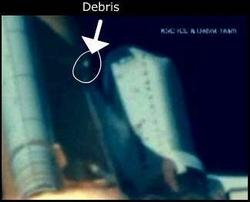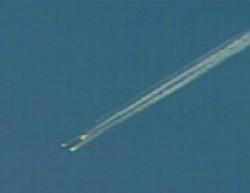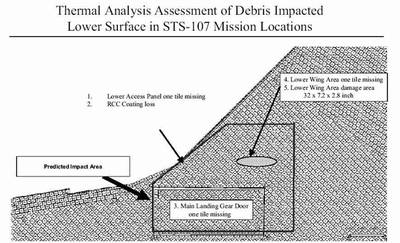Boeing Thermal Engineer: "I've Never Seen A Strike This
Big."
 Veteran engineers at shuttle contractor Boeing say
their company falsely led NASA officials to believe the space
shuttle Columbia was safe to land because top managers
assigned the task of assessing launch damage to Boeing workers
who'd never done that type of analysis before.
Veteran engineers at shuttle contractor Boeing say
their company falsely led NASA officials to believe the space
shuttle Columbia was safe to land because top managers
assigned the task of assessing launch damage to Boeing workers
who'd never done that type of analysis before.
The Sunday edition of the Miami Herald quotes a thermal
systems engineer who did this kind of analysis for 10 years in
California before Boeing shifted the work to its Houston offices
last year as saying, "I think they wanted to paint a rosy picture,
and they did. In my experience, I have never seen a strike this
big."
"I think they are trying to build a case to protect their asses
for running with faulty thermal analysis."
Herald interviews with engineers at the Boeing plant in
Huntington Beach (CA), lend credence to claims by experts outside
NASA who say Boeing made huge mistakes in its evaluation of wounds
the shuttle may have suffered when debris slammed into its left
wing during lift-off.
In an internal e-mail at Boeing/Huntington Beach, an unnamed
employee speculated NASA has been downplaying the debris strike to
fend off criticism the space agency might not have done enough to
get the astronauts home safely.
"The NASA boys are `back-pedaling' on the original theory of
debris impact," the Boeing employee wrote. "I think they are trying
to build a case to protect their asses for running with faulty
thermal analysis."

Several engineers here began their own analysis after the crash
- using the same data and procedures that were used in Houston
during the flight. The Herald reports those results are
not only different, but they indicate that NASA had an emergency on
its hands.
"We're redoing the analysis because we think it needs to be done
differently," said another longtime shuttle engineer, an expert at
calculating debris impact. "The re-analysis is finding things to be
more harsh than the original."
An independent panel investigating the disaster has so far
determined only that some type of breach allowed searing gases to
enter the shuttle and melt its aluminum frame.
One possible cause of this is that the orbiter's
thermal-protective tiles were damaged or missing, leaving the
ship's thin aluminum skin vulnerable to a "burn-through."
When debris sloughed off the external fuel tank 81 seconds into
launch and hit the wing, engineers began focusing on just such a
contingency. With Columbia still in flight, NASA asked
Boeing to evaluate whether the damage could flare up into a
burn-through during re-entry.
First Flight For Boeing Houston Team
 The
engineers at Boeing's plant in Huntington Beach, Calif., say they
had done these analyses for 20 years. But this year, they were not
asked to.
The
engineers at Boeing's plant in Huntington Beach, Calif., say they
had done these analyses for 20 years. But this year, they were not
asked to.
The reason, they say: Boeing transferred shuttle jobs to Houston
in a consolidation that has cost the company scores of its most
experienced shuttle engineers during the past two years - including
some of those who invented the methodology for debris damage and
thermal analysis.
As Columbia headed toward re-entry, Boeing managers
instead relied on a Houston-based team of engineers who had never
done this type of analysis in a real situation.
"This was their first flight," said the Boeing thermal systems
engineer. "This was the first time they took over."
Boeing spokeswoman Kari Allen said Friday she didn't know if
that was true. "There's a whole lot of people who put that analysis
together. Just because there were four names on the front doesn't
mean there weren't many other people."
The Houston team analyzed a number of scenarios, ultimately
predicting a "safe return" for Columbia. Boeing executives
say that analysis as the "best answers possible" from the "best
technical minds." On Friday, Allen said the company "absolutely"
stood by that statement, even as new e-mails released from NASA
last week suggested some inside the agency voiced strong
doubts.
The Miami Herald reports Boeing's Huntington Beach
engineers - who helped invent the process - say the Boeing team in
Houston grossly mis-analyzed the data.

"Basically, they just didn't interpret the numbers right," the
thermal systems engineer said. "They never properly identified the
risk."
Four Boeing employees and contractors spoke for this report.
Each has at least a decade of experience with the shuttle program.
They say company vice presidents ordered them not to talk to the
press in a Feb. 13 meeting in the company cafeteria.
Their interviews with The Miami Herald echo the
statements of numerous outside experts who have said the thermal
analysis were flawed. And they raise a haunting question in the
aftermath of the Feb. 1 shuttle disintegration: Could NASA have
saved the seven astronauts had it properly assessed the risk?
Crater Program Disregarded?
After the disaster, the California engineers say they were
shocked to see the data that Boeing and NASA used to reach their
conclusions. One chart relied on a computer program called "Crater"
to come up with nine different damage scenarios. Any one of them
could have been catastrophic, the thermal engineer here said, but
the Houston analysts downplayed the results by saying that "Crater"
tended to be conservative.
 Outside experts say it makes no sense to have
rejected methods that brought other shuttles home safely.
Outside experts say it makes no sense to have
rejected methods that brought other shuttles home safely.
One scenario, for example, predicted a two-foot-long,
seven-inch-wide swath of missing tiles.
"When something like that hits you and your computer program
tells you you're all the way through the thermal protection system
for that big of an area, you're in big trouble," the thermal
systems engineer said.
"We had never seen a chart as bad as that."
The evaluation, completed on January 23, assumed only one
piece of debris hit the shuttle. Yet a January 24 debris impact
analysis showed that three pieces of debris may have struck the
orbiter ("Columbia Hit By Foam As Many As Three Times,"
ANN, Feb. 23, 2003).
Was Anybody Listening?
At this point, there is some question as to whether the
consequences of a possible triple impact were ever addressed.
During past flights, when shuttles sustained even minor tile
damage, the Boeing thermal analysis team warned NASA managers of
potential risks so they could take preventive measures.
When Atlantis flew in May 2000, for example, a smaller debris
strike prompted flight directors to take a safety measure called
"cold soaking" before the ship hit the atmosphere. This means they
positioned the damaged area so it faced away from the sun, leaving
it extra cold by the time it was subjected to the heat of re-entry.
Atlantis landed at night.
NASA managers have also speculated that, if there was a serious
risk of one wing falling apart, the shuttle could come in at a
slightly different angle to put more heat on the good wing.
After the crash, NASA has repeatedly tried to downplay the
possibility that damage caused by the debris that hit the orbiter's
left wing actually led to the crash. Last week, NASA Administrator
Sean O'Keefe mocked reporters for focusing so much on foam, calling
them "foamologists."
But the internal e-mails circulating among Boeing engineers in
Huntington Beach shows at least some have lingering doubts.
"NASA and Boeing Management are doing whatever they can to
redirect attention away from that thermal analysis that was done by
inexperienced thermal engineers rather than the guys that would
normally have done it," it says.
 Classic Aero-TV: The Switchblade Flying Car FLIES!
Classic Aero-TV: The Switchblade Flying Car FLIES! ANN FAQ: Q&A 101
ANN FAQ: Q&A 101 ANN's Daily Aero-Term (04.12.24): Discrete Code
ANN's Daily Aero-Term (04.12.24): Discrete Code ANN's Daily Aero-Term (04.13.24): Beyond Visual Line Of Sight (BVLOS)
ANN's Daily Aero-Term (04.13.24): Beyond Visual Line Of Sight (BVLOS) ANN's Daily Aero-Linx (04.13.24)
ANN's Daily Aero-Linx (04.13.24)






